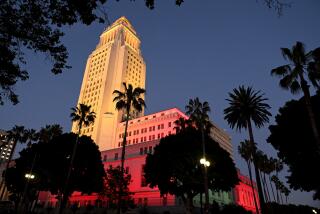Riordan Barrels Ahead on City Charter Reform : Los Angeles: The mayor takes charter overhaul out of the council’s hands, even offers to finance the effort to put it on the spring ballot.
After a brief period of reconciliation, Mayor Richard Riordan has not only resumed his battle with the City Council; he also has upped the ante. His closest political advisor has been sounding out opponents to run against council members Rita Walters and Laura Chick. And he has offered to bankroll a citizens’ initiative on charter reform, which has the short-term objective of removing the council from the charter reform process and the long-term goal of eliminating the council altogether.
For years, specialists in Los Angeles government have bemoaned the charter passed by the voters in 1925. The city’s elites wanted to limit both democratic movements and political corruption. So they devised a relatively weak mayoralty, a strong council and a complicated system of citizen commissions to oversee city departments. As a result, Los Angeles government lacks simple, clear lines of accountability.
The mayor probably has too little power, although it can be greatly magnified by a good working relationship with the city council. And there is no real utility to the citizen commissions, which are appointed by the mayor with the council’s consent. A new charter could both strengthen the mayor and improve the council’s ability to provide effective oversight of the executive branch without without having to approve every paper clip in the mayor’s office.
The renewed interest in changing the charter was sparked by the boomlet for Valley secession. An ultimately unsuccessful bill by Assemblywoman Paula Boland of Granada Hills would have eliminated the council’s veto power over secession and restricted voting in a secession referendum to residents of the San Fernando Valley.
Several members of the council were spurred to find ways to respond to the growing alienation from City Hall. While Joel Wachs pursued a plan for neighborhood councils, Michael Feuer explored reform of the city charter.
Working with Feuer was Dave Fleming, a Riordan-appointed member of the Fire Commission from the Valley. But when Feuer marked out an important role for the council in the reform process, Fleming proposed instead a ballot proposition that would leave charter reform to the voters. Riordan not only embraced the idea; he also offered to fund the signature-gathering effort, which could cost up to $800,000.
Fleming’s plan would ask the voters in the spring 1997 election (the mayoral primary) to set up a charter reform commission and to select 15 commissioners from a list of candidates. This commission would be empowered to develop a new city charter and to place it on another ballot without the participation of the City Council. The mayor would have unrivaled influence in this process, which, after all, he would be paying for.
Fleming’s own proposal would greatly strengthen the mayor’s office and set up 30 to 40 neighborhood councils. These councils would control growth and development policy in the neighborhoods. The president of each council would sit on a citywide board that would meet occasionally. The City Council, in its present form, would be eliminated.
This ill-advised plan, making the mayor responsible to a part-time and divided semi-legislature, would only worsen the problems of city government.
It is true that legislatures cannot lead the government; only executives can. But legislative bodies, far better than executives, can represent the people. They reflect the clash of diverse interests and communities. The people may not like legislatures as institutions, but they usually like their own legislators, who are seen as responsive to their interests. And they expect legislatures to keep a watchful eye on executives.
In 1925, the voters took the representative role of the City Council very seriously. Despite great pressure from the city’s power structure, the voters chose to elect council members by district rather than at-large. District elections were crucial in gaining minority representation on the council decades later. In 1991, the voters approved Charter Amendment 5, increasing the council’s power over city commissions.
The mayor’s intervention has certainly brought charter reform, with its potential for changing the mayor-council balance of power, to everybody’s attention. But charter change should be done well, for its effects will last long after this mayor’s battle with this council. It is imperative that the city’s leaders work together to appoint an outstanding charter reform commission, whose recommendations (like those of the Christopher Commission) will carry sufficient weight to overcome parochial objections from elected officials. If public officials resist a good plan, the ballot path will still be available. The city’s charter is too important to become a political football in an election year.
More to Read
Sign up for Essential California
The most important California stories and recommendations in your inbox every morning.
You may occasionally receive promotional content from the Los Angeles Times.










